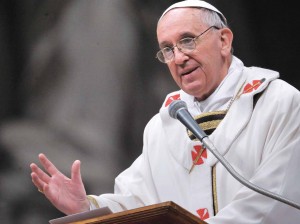 Reflecting on the 50 anniversary of the historic Vatican II declaration Nostra Aetate, Pope Francis lauded the document for proposing to every Christian “the rediscovery of the Jewish roots of Christianity.”
Reflecting on the 50 anniversary of the historic Vatican II declaration Nostra Aetate, Pope Francis lauded the document for proposing to every Christian “the rediscovery of the Jewish roots of Christianity.”
Speaking in cinematic terms to give ourselves a frame of reference, is Christianity a remake (or re-boot), a sequel, or a spin-off of Judaism? Or is it a new project, altogether, which happened to grow up along an “elder brother”?
Nostra Aetate itself—the ‘magna carta’ on the Church’s relationship with non-Christians, hints at the answer when it states that “the Church of Christ acknowledges that, according to God’s saving design, the beginnings of her faith and her election are found already among the Patriarchs, Moses and the prophets.” (Nostra ætate, 4).
We all probably intuit this truth, because the “Jewish bible” is contained within our Scripture as “the Old Testament.” We meet Moses and the prophets, and most of us understand that Jesus and his friends grew up Jewish, and that there is therefore a distinctly Jewish frame of reference in the culture and the religion that develops around Jesus.
In truth, the relationship is much more profound. Christianity is not merely “set” in the Jewish world, nor is it just a “sequel” that presents subsequent adventures and events to Jewish scripture. Christianity presupposes the authority of the Jewish texts, recognizing their validity, and relying on their authority to justify or establish its premises.
At a deeper level, we believe that Christ came to fulfill the Scriptures (Matthew 5:17-20.) We profess that Jesus died and “was buried, and that he rose again the third day according to the scriptures” (1 Corinthians 15:4). We believe that his mission was foretold in those scriptures and that his ministry fulfilled God’s ancient promises.
We are presented with a searing icon of Christ’s fulfillment of those scriptures in the Gospel account of the Transfiguration. (Cf., Matthew 17:1–9, Mark 9:2–8, Luke 9:28–36.) Jesus takes three of his disciples (Peter, James and John) up to the holy mountain to pray and, while there, they see him radiate a brilliant light and appear alongside the Old Testament heroes Moses and Elijah. A voice from the clouds commands the apostles to “hear” him.
That stamp of Jesus between Moses and Elijah identified as the one to be heard epitomizes Jesus as the fulfilment of the law and the prophets. Moses is the great lawgiver in the Old Testament, and Elijah is the great prophet. Now, Jesus is come, threaded through the divine history of Israel, to be presented to us as the pinnacle of that history and the fulfilment of God’s promises.
Initially, the young St. Augustine rejected Christianity because it was presented to him in a version shorn of the messy Jewish scriptures by a sect which proposed a Christianity of pure and simple reason in which an esoteric Christ leads people to self-knowledge. It was only later in life, when Augustine understood the relationship of Israel’s Bible to Christ that he discovered the wisdom for which he had been searching.
Whether it is to understand the Messianic expectation and the rooting of Christ’s salvific mission, to contemplate Israel as a “model” people/nation, to learn the moral preaching of the prophets, or to apprehend the nature of God’s covenant with humanity, rediscovering the Jewish roots of our faith is the key to a deeper understanding of Christianity.



